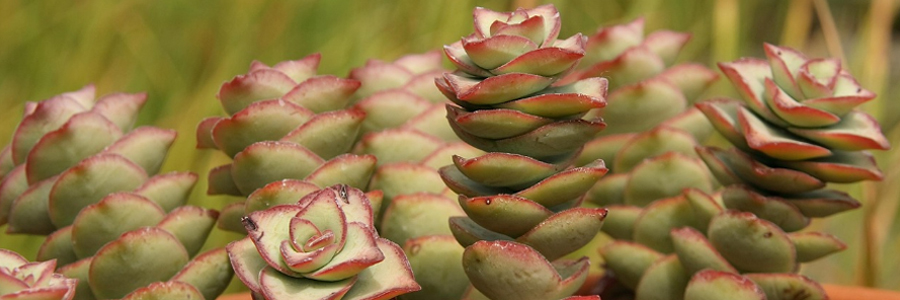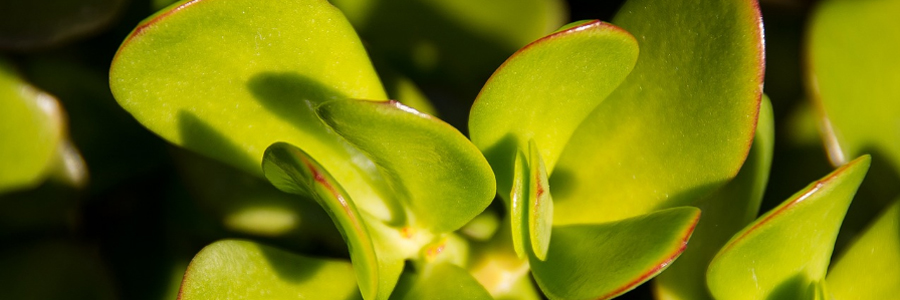Crassula
Taxonomic Classification
The Crassula genus belongs to the family Crassulaceae. It is a large and diverse genus, consisting of over 200 species of succulent plants. The name “Crassula” is derived from the Latin word “crassus”, which means thick or stout, referring to the fleshy leaves characteristic of plants in this genus. Native to various regions around the world, particularly Africa, Madagascar, and South America, Crassula species have adapted to a wide range of habitats, from arid deserts to mountainous areas with more moderate climates.
Morphological Characteristics
1.Leaf Structure
Crassula plants are known for their unique leaf arrangements and shapes. The leaves are typically thick and succulent, adapted for water storage. They can be arranged in opposite pairs, in whorls around the stem, or in a rosette pattern. The leaf shapes vary greatly, including oval, round, triangular, and even club – shaped. For example, in Crassula ovata (the Jade Plant), the leaves are thick, oval – shaped, and grow in an alternating pattern along the stem. In Crassula perforata, the leaves are arranged in a stacked, ladder – like pattern, creating an interesting and distinctive appearance.
2.Stem and Growth Habit
The stems of Crassula plants can be either woody or herbaceous, depending on the species. Some species, like Crassula arborescens, develop woody stems over time and can grow into small shrubs, reaching heights of up to 1 – 2 meters. Others, such as Crassula multicava, are low – growing and form mats or small clumps. The growth habit can be upright, spreading, or trailing, adding to the diversity within the genus.
3.Flowering Characteristics
When Crassula plants flower, they produce clusters of small, often star – shaped flowers. The flowers can be white, pink, red, or yellow, depending on the species. The flower clusters are usually borne on long stalks that emerge from the center of the plant or from the axils of the leaves. Flowering typically occurs in spring or summer, but some species may flower at other times of the year. The flowers are often attractive to pollinators such as bees and butterflies.
Common Varieties
1.Crassula ovata
Also known as the Jade Plant or Money Tree, Crassula ovata is one of the most well – known and popular Crassula species. It has thick, glossy, oval – shaped leaves that are usually green but can develop a red tinge at the edges when exposed to bright light. The plant can grow into a small tree – like form, with a woody stem and branches. It is relatively easy to care for and is a common houseplant. Crassula ovata is believed to bring good luck and prosperity in some cultures, which has contributed to its popularity.
2.Crassula perforata
Commonly called String of Buttons, Crassula perforata has unique, stacked leaves that resemble a string of buttons. The leaves are small, triangular – shaped, and grow in a cylindrical pattern along the stem. The plant has a trailing growth habit and is often used in hanging baskets or as ground cover in rock gardens. It produces small, white flowers in summer, which add to its charm.
3.Crassula multicava
This species forms low – growing mats of small, round – shaped leaves. The leaves are tightly packed and have a green color, often with a red or purple tinge at the tips. Crassula multicava is a hardy plant that can tolerate a wide range of conditions. It produces clusters of small, white flowers in spring or summer. It is a great choice for rock gardens, terrariums, or as a border plant in succulent gardens.
4.Crassula arborescens
Crassula arborescens, also known as Silver Dollar Plant, has large, round, silver – gray leaves. The leaves are covered in a powdery coating, which helps to protect the plant from excessive sunlight and water loss. The plant can grow into a small shrub, with a woody stem and multiple branches. It produces clusters of small, white or pinkish flowers in summer. Crassula arborescens is well – adapted to dry, sunny conditions and is a popular choice for xeriscapes.
5.Crassula capitella ‘Campfire’
This variety of Crassula capitella is highly prized for its vibrant, red – orange foliage. The leaves are narrow and pointed, and they grow in a rosette pattern at the end of the stems. As the plant matures, the foliage turns a deep, fiery red, especially when exposed to bright light and cooler temperatures. It produces small, white flowers, but the main attraction is its colorful leaves. Crassula capitella ‘Campfire’ is often used in mixed succulent containers and as a focal point in succulent gardens.


